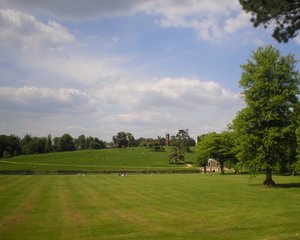Stowe, Buckinghamshire
|
|
Stowe_from_Jones's_Views_(1819).JPG
Stowe is the name shared by an ancient village, country house and school (Stowe School) in Buckinghamshire in England. It is situated about 2 miles north-northeast of Buckingham. The breathtaking landscape gardens, including its many monuments, were acquired by the National Trust in 1990 and are open to the public. The National Trust are currently overseeing a complete restoration program of the grounds, temples and follies.
Originally the village of Stowe was built in the Anglo Saxon period. Its name refers to an ancient holy place of some eminence with the local community. The village remained in place up until 1712 when the 31 houses of the village were demolished to make way for the extensive gardens of the manor. The small parish church still survives in the shadow of the great house, and Christian worship still takes place there every Sunday. Within the parish border of Stowe lie the hamlets of Boycott, Dadford and Lamport.
In the early 17th century, the manor of Stowe was completely rebuilt by Sir Richard Temple, from the old medieval stronghold to what is now the core of the impressive mansion for which the area is known today. Having been redesigned and perfected subsequently over the years, the whole front is now 916 feet in length and is a breathtaking sight as you approach from the direction of Buckingham. The long, straight driveway that ran from Buckingham all the way to the front of the house, passing through a 60-foot Corinthian arch on the brow of the hill on the way, made for a breathtaking approach that was very humbling and intimidating for visitors to the house. The driveway approach to the house is still in use today.
In the 1690s Stowe had a modest early-Baroque parterre garden, owing more to Italy than to France, but it has not survived, and within a relatively short time, Stowe became widely renowned for its magnificent gardens. In the 1710s and 1720s, Charles Bridgeman (garden designer) and John Vanbrugh (architect) designed an English Baroque park, inspired by the work of London, Wise and Switzer. In the 1730s, William Kent and James Gibbs were appointed to work with Bridgeman, who died in 1738. Kent had already created the glorious garden at Rousham House, and he was joined by Giacomo Leoni to build temples, bridges and other garden structures. Kent’s Temple of Ancient Virtue (1734) looks across the Elysian Fields to the Shrine of British Worthies. In 1741, Capability Brown was appointed head gardener. He worked with Kent until the latter’s death in 1748, and his own departure in 1751. In these years, Bridgeman’s Octagonal Pond and Eleven Acre Lake were given a "natural" shape, and a Palladian Bridge was added in 1744. Brown made a Grecian Valley which, despite its name, is an abstract composition of landform and woodland. As Loudon remarked in 1831, 'nature has done little or nothing; man a great deal, and time has improved his labours'.
As Stowe evolved from an English Baroque garden into a pioneering landscape park, the gardens became an attraction for many of the nobility, including political leaders. Indeed, Stowe is said to be the first English garden for which a guide book was produced. Wars and rebellions were reputedly discussed among the garden's many temples; the artwork of the time reflecting this by portraying caricatures of the better known politicians of history. Stowe began to evolve into a series of natural pictures to be appreciated from a perambulation rather than from a central point.
From 1784, Stowe was the seat of the Marquesses of Buckingham. The 2nd Marquess of Buckingham married the heiress of the last Duke of Chandos and was then created Duke of Buckingham and Chandos. Richard Plantagenet Campbell Temple-Nugent-Brydges-Chandos-Grenville, 3rd Duke of Buckingham and Chandos (10 September 1823–26 March 1889), usually shortened to Richard Temple-Grenville, was a British statesman of the 19th century, and a close friend and subordinate of Benjamin Disraeli. He was styled Marquess of Chandos until the death of his father in 1861.
Earl Temple of Stowe is a title in the Peerage of the United Kingdom. It was bestowed in 1822 to Richard Temple-Nugent-Brydges-Chandos-Grenville, who had been earlier created Duke of Buckingham. With the death of the third Duke, there remained no heirs-male to the dukedom, so it became extinct. The Earldom, however, had a special remainder in the letters patent creating it that allowed it to descend in the female line, which it did, to the first Duke's great-grandson William Gore-Langton. The house remained the seat of the Dukes of Buckingham and Chandos until the extinction of that title in 1889, and then of the Earls Temple of Stowe until the early 20th century, when, due to prodigious debts, the house was sold to become a school.
The Bollywood film Kabhi Khushi Kabhi Gham was filmed in Stowe (opening scene with the cricket match).
There are also other films filmed in Stowe including Indiana Jones and the Last Crusade as Berlin, Proof of Life and James Bond The World Is Not Enough.
See also
External links
- Stowe Gardens - information (http://www.gardenvisit.com/g/stowe1.htm)
- Stowe School Website (http://www.stoweschool.org/)

